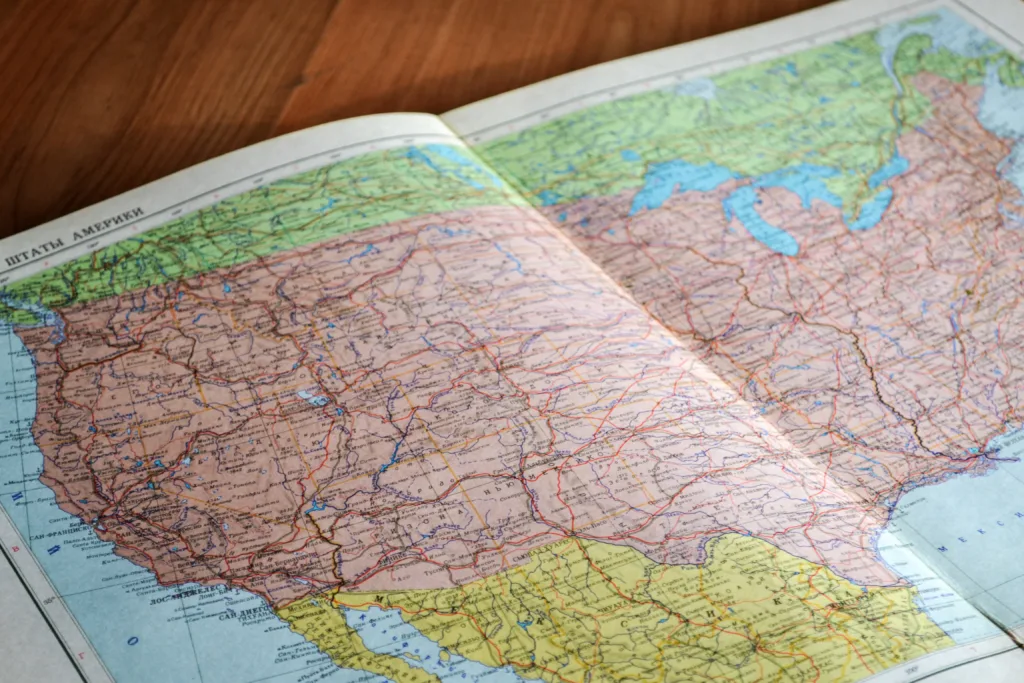The Eastern United States is a vast region that encompasses a variety of landscapes, cultures, and climates. This region is divided into four distinct subregions, each with its own unique characteristics and attractions. Let’s delve into each subregion and explore what makes them special.
1. New England:
Located in the northeastern corner of the United States, New England is known for its rich history and picturesque landscapes. Consisting of six states – Connecticut, Maine, Massachusetts, New Hampshire, Rhode Island, and Vermont – this subregion offers a blend of charming coastal towns, vibrant cities, and stunning natural beauty. Visitors can explore iconic landmarks such as Boston’s Freedom Trail, Cape Cod’s sandy beaches, Vermont’s scenic Green Mountains, and Maine’s rugged coastline.
2. Mid-Atlantic:
Stretching from New York to Maryland, the Mid-Atlantic subregion is a bustling and diverse area. This region includes states like New York, New Jersey, Pennsylvania, Delaware, and Maryland. The Mid-Atlantic is home to iconic cities like New York City and Philadelphia, offering world-class cultural attractions, renowned museums, and vibrant nightlife. Visitors can also explore the historic charm of colonial towns such as Annapolis and visit the beautiful beaches of the Jersey Shore.
3. Southeast:
The Southeast subregion is a vibrant mix of history, natural beauty, and southern hospitality. Comprising states like Virginia, West Virginia, North Carolina, South Carolina, Georgia, Florida, Alabama, Mississippi, Tennessee, and Kentucky, this region offers a diverse range of experiences. From the historic landmarks of Williamsburg and Charleston to the stunning beaches of Florida and the Great Smoky Mountains, the Southeast has something for everyone. Visitors can also indulge in the delicious cuisine, lively music scene, and warm hospitality that the region is known for.
4. Midwest:
Although geographically located in the central part of the country, the Midwest is often considered part of the Eastern United States. This subregion includes states such as Ohio, Michigan, Indiana, Illinois, Wisconsin, and Minnesota. The Midwest is known for its vast plains, fertile farmlands, and vibrant cities. Visitors can explore the architectural wonders of Chicago, visit the iconic Mall of America in Minnesota, or immerse themselves in the natural beauty of the Great Lakes.
Each subregion of the Eastern United States has its own distinct characteristics and attractions, offering visitors a diverse range of experiences. Whether you are interested in history, nature, culture, or simply exploring new destinations, the Eastern United States has something to offer everyone. So pack your bags and embark on a journey to discover the beauty of this fascinating region.
Why Do Geographers Divide The Eastern US Into 4 Subregions?
Geographers divide the eastern US into four subregions because it helps to better understand and analyze the unique characteristics and patterns within this larger region. The division allows geographers to focus on specific areas and identify commonalities, which in turn aids in studying and explaining various phenomena.
1. Environmental Factors: The eastern US is vast and diverse in terms of its physical geography, including climate, landforms, and natural resources. By dividing it into subregions, geographers can examine how these environmental factors differ and influence human activities, such as agriculture, industry, and settlement patterns.
2. Cultural and Social Differences: The eastern US is home to a wide range of cultural and social groups, each with its own distinct traditions, customs, and beliefs. Dividing the region into subregions helps geographers analyze and understand the cultural and social dynamics within each area, including language, religion, ethnicity, and socioeconomic factors.
3. Economic Activities: The eastern US is a significant economic hub, with various industries and economic activities driving the region’s development. By dividing the region into subregions, geographers can focus on specific economic sectors, such as manufacturing, finance, tourism, and agriculture, and examine the factors that contribute to their growth or decline in each area.
4. Political and Administrative Boundaries: The eastern US is divided into different states, each with its own governance and administrative structures. These political boundaries often influence economic, social, and environmental factors within a specific area. By dividing the region into subregions, geographers can take into account the impact of political and administrative boundaries on various aspects, such as policy-making, infrastructure development, and resource allocation.
Geographers divide the eastern US into four subregions to better understand and analyze the region’s environmental, cultural, social, economic, and political characteristics. This division allows for a more focused study of the unique patterns and interactions within each subregion, contributing to a comprehensive understanding of the entire eastern US.

How Many Subregions Are In The United States?
According to the US Census Bureau, the United States is divided into four main regions: Northeast, Midwest, South, and West. These regions are further divided into nine subregions. The purpose of these subregions is to provide a more detailed classification of the different areas within each main region. The nine subregions are as follows:
1. Northeast Region:
– New England (Maine, New Hampshire, Vermont, Massachusetts, Rhode Island, Connecticut)
– Mid-Atlantic (New York, New Jersey, Pennsylvania)
2. Midwest Region:
– East North Central (Ohio, Indiana, Illinois, Michigan, Wisconsin)
– West North Central (Minnesota, Iowa, Missouri, North Dakota, South Dakota, Nebraska, Kansas)
3. South Region:
– South Atlantic (Delaware, Maryland, District of Columbia, Virginia, West Virginia, North Carolina, South Carolina, Georgia, Florida)
– East South Central (Kentucky, Tennessee, Alabama, Mississippi)
– West South Central (Arkansas, Louisiana, Oklahoma, Texas)
4. West Region:
– Mountain (Montana, Idaho, Wyoming, Colorado, New Mexico, Arizona, Utah, Nevada)
– Pacific (Washington, Oregon, California, Alaska, Hawaii)
These subregions help to provide a more nuanced understanding of the geographical and cultural diversity within the United States. They are used for various purposes, including demographic analysis, economic research, and policy planning.
Which Of The 4 Eastern Subregions Of The US Does Not Border The Atlantic Ocean?
The subregion of the United States that does not border the Atlantic Ocean is the Western Great Lakes region. This region includes states such as Wisconsin, Michigan, Illinois, Indiana, and Ohio. Although these states are located in the eastern part of the country, they do not have direct access to the Atlantic Ocean. Instead, they are surrounded by the Great Lakes, particularly Lake Michigan. These states are part of the larger Great Lakes region, which is known for its freshwater bodies and their importance for transportation, commerce, and recreation.
In contrast, the other three subregions of the eastern United States do have coastlines along the Atlantic Ocean. The Southern subregion includes states like Florida, Georgia, and South Carolina, while the Central subregion includes North Carolina and Virginia. The northeastern subregion stretches from the Maryland coast all the way up to Maine. These areas are known for their beautiful beaches, diverse marine life, and vibrant coastal communities.
What Are The Four Subregions East Of The Mississippi River?
The four subregions located east of the Mississippi River are New England, Mid-Atlantic, Southeast, and Midwest. Here is a breakdown of each subregion:
1. New England: This subregion consists of the northeastern states of the United States, including Maine, New Hampshire, Vermont, Massachusetts, Rhode Island, and Connecticut. New England is known for its rich history, picturesque landscapes, and charming coastal towns.
2. Mid-Atlantic: The Mid-Atlantic subregion includes states such as New York, New Jersey, Pennsylvania, Delaware, and Maryland. This region is a melting pot of diverse cultures and is home to bustling cities like New York City and Philadelphia.
3. Southeast: The Southeast subregion encompasses states such as Virginia, West Virginia, North Carolina, South Carolina, Georgia, Florida, Alabama, Mississippi, Tennessee, Kentucky, and Louisiana. Known for its warm climate, beautiful beaches, and Southern hospitality, the Southeast is a popular tourist destination.
4. Midwest: The Midwest subregion includes states such as Ohio, Indiana, Illinois, Michigan, Wisconsin, Minnesota, Iowa, Missouri, North Dakota, South Dakota, Nebraska, and Kansas. This region is often referred to as the “Heartland” of America and is known for its agricultural productivity and vast open spaces.
Each of these subregions has its unique physical features, cultural characteristics, and economic activities that contribute to the overall diversity and richness of the eastern United States.

Conclusion
The Eastern United States is a diverse and dynamic region with distinct physical features and characteristics. It is divided into several subregions, including New England, the Mid-Atlantic, the Southeast, and the Midwest. Each subregion has its own unique cultural, historical, and economic attributes that contribute to the overall richness and complexity of the Eastern United States.
The Eastern United States is known for its stunning natural beauty, with the Atlantic Ocean bordering much of the region and providing opportunities for coastal activities and tourism. The region is also home to the Appalachian Mountains, which offer breathtaking landscapes and outdoor recreational activities such as hiking, camping, and skiing.
Culturally, the Eastern United States is a melting pot of different traditions and influences. New England is known for its colonial history and charming small towns, while the Mid-Atlantic region is home to bustling cities like Washington, D.C. and New York City, which are centers of politics, commerce, and culture. The Southeast is famous for its warm climate, hospitality, and unique cuisine, while the Midwest is known as the “Nation’s Bread Basket” due to its rich agricultural resources.
Economically, the Eastern United States is a powerhouse, with a diverse range of industries driving its prosperity. The region is home to major financial centers, manufacturing hubs, technology companies, and a thriving tourism industry. It is also a major transportation hub, with numerous airports, ports, and highways connecting it to other parts of the country and the world.
The Eastern United States is a fascinating and vibrant region that offers something for everyone. Its diverse landscapes, rich history, and economic opportunities make it a compelling destination for both residents and visitors alike.
